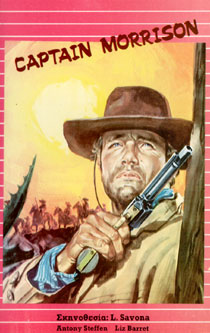 |
| KILLER KID |
 |
 Greek video cover for Killer Kid
Greek video cover for Killer Kid |
Aka Captain Morrison (US), Chamaco (WG)
1967
Italy
Director: Leopoldo Savona
Story & screenplay: Leopoldo Savona, Sergio Garrone, Ottavio Poggi
Cinematography: Sandro Mancori (laboratory: Tecnostampa ( Rome ) - Cromoscope)
Music: Berto Pisano
Editor: Luciano Anconetani
Set decorator: Pierluigi Basile
Interiors filmed at Cinecitta and Elios Film (both Rome )
Release dates + running times: Italy (registered 22.09.67, first shown 30.09.67), Germany (20.06.68, 88 mins), Spain (101 mins)
Italian takings: 64.000.000 lire
Spanish takings: 78.769,93 €
Cast: Anthony Steffen [Antonio De Teffè] (
Scott, aka Killer Kid, aka Capt Morrison), Fernando Sancho (
Vilar, El Santo's lieutenant), Liz Barrett [Luisa Baratto] (
Mercedes Hernandes, El Santo's niece), Ken Wood [Gianfranco Cianfriglia] (
Ramirez), Nelson Rubien (
El Santo, revolutionary leader), Virgin Darwell (
Dolores), Adriano Vitale, Yorgo Voyagis (
Pablo, one of Vilar's men), Domenico Cianfriglia (
Ortez, El Santo's lieutenant), Bruno Arie, Macchi Valentino [Valentino Macchi], Ugo Adinolfi (
Ramirez man questioned by Vilar)
Uncredited: Tommaso Felleghy (
Barnes, a gun runner), Consalvo Dell'Arti (
the Commander), Fedele Gentile (
Captain Garrison)
Well, it's mucho muchacho in this early example of the political spaghetti western, a film that also happens to be one of my personal favourites of the entire genre. It's a hugely convoluted tale of gurning, intrigue and villainy which, despite attempting to throw every conceivable narrative gimmick into the mix, manages to sustain a distinct sense of individuality.
The commander of an army outpost just next to Mexico has a major problem; a cargo of military weapons has been stolen by gunrunners and they plan to sell it to the revolutionaries south of the border. This is particularly worrying because it could implicate the US in the trade, thus dragging them into a protracted and bloody war. Also proving troublesome is one of their prisoners, The Killer Kid (Anthony Steffen), who is apparently the most notorious gunman in the West. He's also quite a nifty escape artist, and manages to slip from their grasp with suspicious ease.
For some reason, he seems to have an unhealthy interest in the smugglers, watching as they are almost double-crossed by the rather hapless Vilar (Fernando Sancho in a typically bombastic performance). After saving the life of a wounded revolutionary he is taken to the headquarters of El Santo, the leader and figurehead of the rebellion. Unfortunately, both The Kid and the revolutionaries are being pursued by the dogged and brutal Capt. Ramirez (Ken Wood), who attacks the village with a squad of his men. They are repelled in a battle that allows the Americano to win the trust of the elderly El Santo, although Vilar (who happens to be his Lieutenant) remains distinctly unconvinced by his gringo charms. It also means that Ramirez becomes increasingly frenzied in his pursuit of his foils.
The Kid's motivations, however, are becoming increasingly unclear - most notably so when he secretly pushes a wagonload of ammunition of a cliff. Unsurprisingly, he is the immediate suspect, and only manages to win a reprieve when he pulls off his distinctive trick of marksmanship: shooting a silver dollar from thirty paces away. This is especially impressive as it is revealed that he isn't actually the Kid, but Cpt. Morrison, an American officer who is impersonating the renowned killer so as infiltrate and end the gun trafficking trade.
This, like many of Steffen's westerns, is a moody affair and all the better for it. He had already perfected the slightly mournful, slightly enigmatic, somewhat vacuous expression that would pervade most of his better performances (he was never quite as successful when he was actually called upon to act). It also has a nice adventure feel to it, with a hero you can cheer on, a hissable villain and a secondary character who comes good in the end after being morally reprehensible for most of the preceding ninety minutes.
The soundtrack is decidedly low-key, with a smattering of Spanish guitar and strings creating exactly the right kind of melancholy tension. The camerawork as one would expect from Sandro Mancori (who also lensed Gianfranco Parolini's Sabata and Sartana amongst many others) is exemplary, making full use of the parched landscapes and fierce sun. Leopoldo Savona directed another two top notch westerns, El Rojo (with Richard Harrison) and Apocalypse Joe (again with Steffen) as well as a number of relatively obscure items in a variety of other genres. Examples include the horror film Byleth (73) and the 1962 war film La guerra continua , which featured Jack Palance of all people. Interestingly the script was co-written by Sergio Garrone , who also acted as 'Production Manager' and would also go on to direct Steffen in probably his best film, Django the Bastard
Matt B

